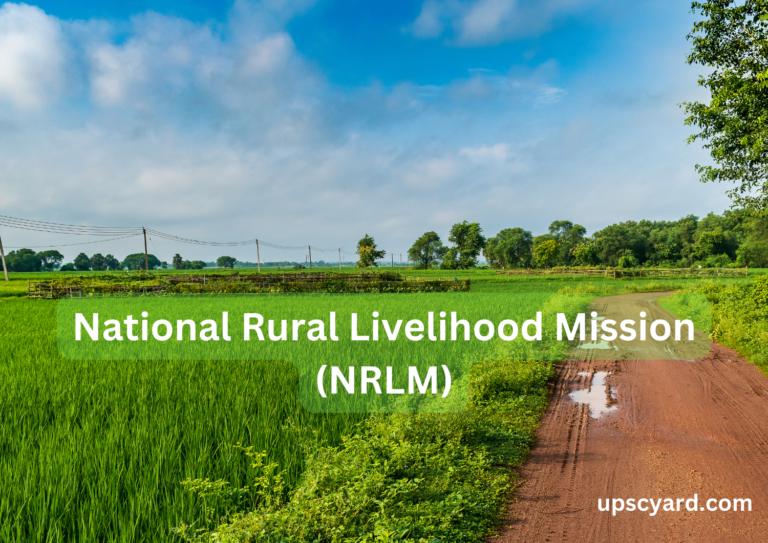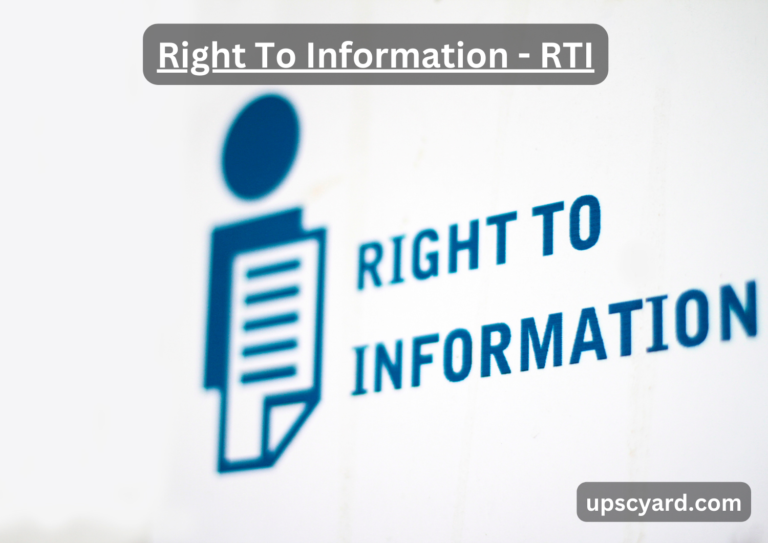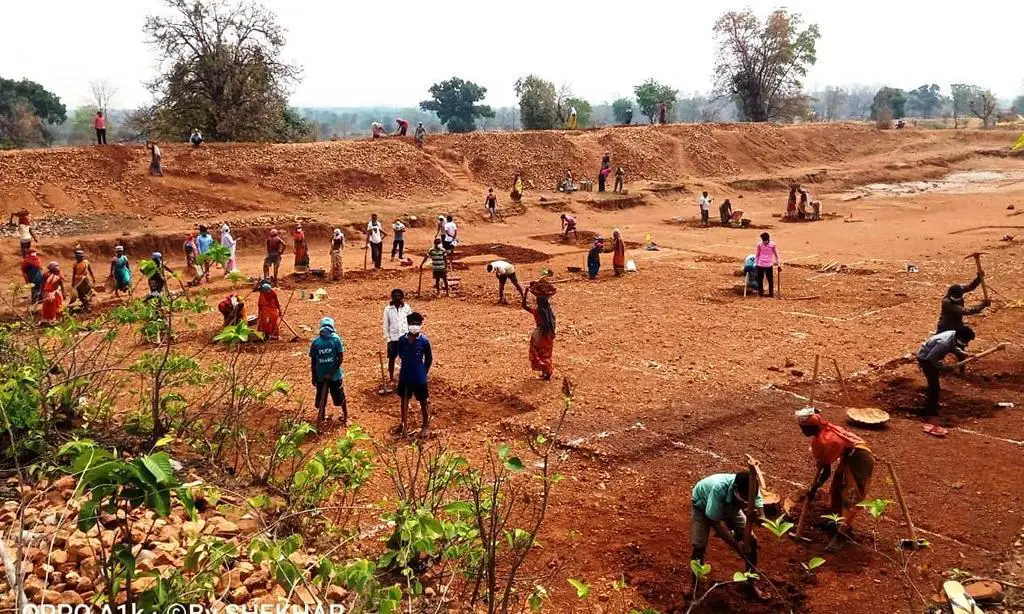
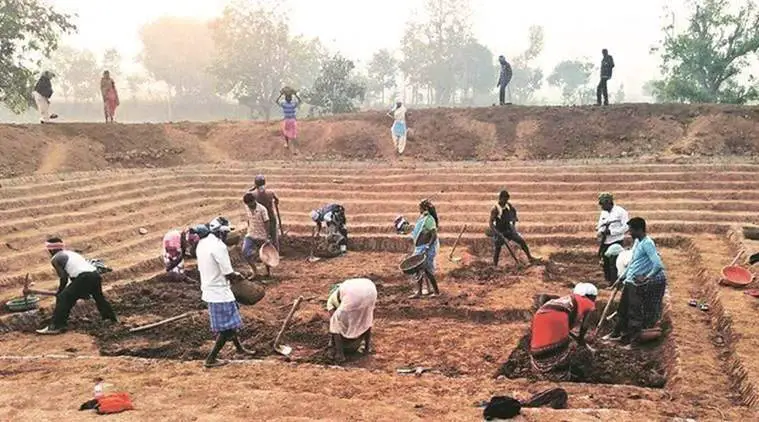
Historical Background: Evolution of MGNREGA
Pre-Independence Era:
The notion of self-reliance in India has deep historical roots, dating back to the colonial era in the 19th century. An Englishwoman named Rachel Metcalf introduced the concept of Quaker Service to India during the famines of 1895-96 and 1899-1900. Her objective was to provide selfless service to humanity during these trying times, making it one of the earliest attempts at rural development in the country. This period also saw the establishment of Swaraj Ashram in 1922 in Baroda, where spinning and weaving tools were used to impart training in self-reliance and self-confidence.
Post-Independence Era:
Following India’s independence, the economic situation was precarious. In response to these challenges, Prime Minister Jawaharlal Nehru adopted a policy of economic self-reliance. This approach aimed to bolster indigenous producers and stimulate domestic production. It took nearly two decades for the government to formulate suitable employment schemes for India’s rural areas, as part of its ongoing efforts to promote self-reliance and economic development in the country.
Historical Progression of Rural Development Programs:
1. Rural Man-Power Programme (1961-1969):
- This program was initiated during this period, aiming to bolster rural manpower. However, it faced challenges due to poor implementation and revealed issues in financial management.
2. Crash Scheme (1973):
- Designed to address rural employment concerns, the Crash Scheme was introduced to provide job opportunities in rural areas.
3. Integrated Rural Development Programme (6th FYP):
- During the 6th Five-Year Plan (FYP), the Integrated Rural Development Programme was launched with the goal of creating an operationally integrated strategy to enhance production and productivity in agriculture and related sectors.
4. Drought Prone Programme (1973):
- Launched in 1973, this program aimed to achieve environmental balance by focusing on the development of groundwater resources, a milestone reached after two decades of dedicated efforts.
5. Marginal Farmers and Agricultural Labourers Agency (1974):
- This initiative, launched in 1974, was geared towards providing technical and financial support to marginal farmers, recognizing their crucial role in agriculture.
6. Food for Work Programme (1977-78):
- Introduced in 1977-78, the Food for Work Programme aimed to distribute food grains to laborers as a means to support their livelihoods.
During the 1970s, the government introduced a total of six programs, all with overlapping objectives:
- Alleviating poverty
- Ensuring food availability for all
- Addressing environmental concerns and maintaining ecological balance in rural areas
7. National Rural Employment Programme (1980):
- Introduced in 1980, the National Rural Employment Programme aimed to create employment opportunities for the rural workforce. However, it did not guarantee employment.
8. Jawahar Rozgar Yojana (RURAL, 1989) & Nehru Rozgar Yojana (URBAN, 1989):
- In 1989, the Jawahar Rozgar Yojana for rural areas and the Nehru Rozgar Yojana for urban areas were launched. They followed the merger of NREP and RLEG (rural landless employment guarantee programme). The objective was to provide 90-100 days of work per person. These programs had three key components: Employment Generation, Infrastructural Development, and Food Security.
9. Employment Assessment Scheme (1991):
- In 1991, then-Prime Minister P.V. Narsimha Rao proposed the introduction of the National Rural Employment Guarantee Act (NREGA), which included the term “guaranteed” employment. Implemented on October 2, 1993, and known as the Employment Assessment Scheme (EAS), it guaranteed 100 days of employment at the village level, with the implementing agency being the Zila Parishad.
10. Swaraj Gramin Rojgar Yojana (2001):
- Launched in 2001, the Swaraj Gramin Rojgar Yojana aimed to provide gainful employment opportunities for the rural poor. It was implemented starting from February 21, 2003, and combined two schemes, EAS and JRY (Jawahar Rozgar Yojana).
11. Mahatma Gandhi National Rural Employment Guarantee Act (MGNREGA) – 2005:
- MGNREGA, with the “MG” added to its name, was notified on September 7, 2005, and included provisions for guaranteed 100 days of work. It was officially launched on February 2, 2006. This program subsumed two previous initiatives, SGRY and the National Food for Work Programme.
MGNREGA is implemented by the Ministry of Rural Development and stands as a flagship program of the government. Initially launched in 200 districts, it has since expanded to cover all districts, with a primary focus on promoting inclusive growth.
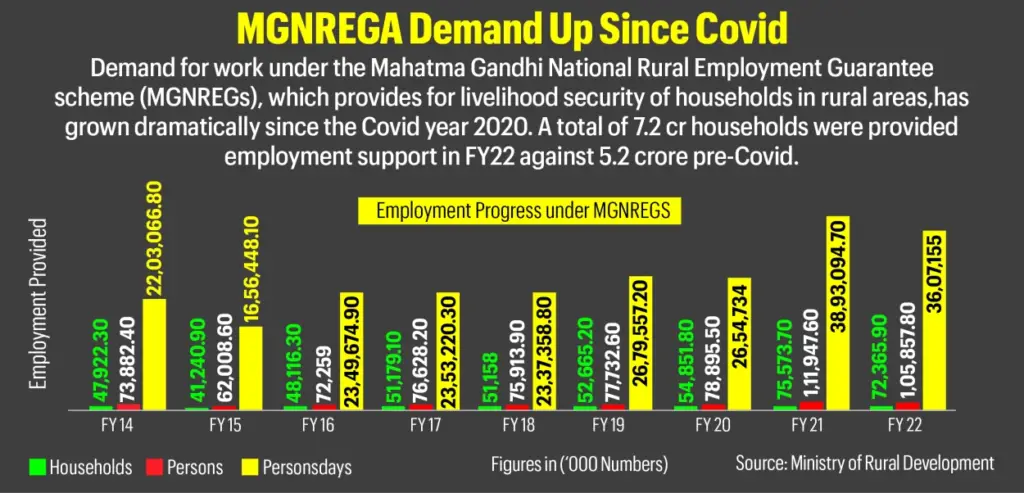
Constitutional Provisions and MGNREGA: Empowering Livelihoods
The Indian Constitution lays the foundation for a just and equitable society. Several key provisions and acts have been put in place to ensure the welfare and livelihoods of the people:
Article 14 – Equality Before the Law:
- This article ensures equality before the law, ensuring that every citizen is treated fairly and without discrimination.
Article 21 – Protection of Life and Liberty:
- Article 21 safeguards the fundamental rights to life and personal liberty, emphasizing the importance of protecting every individual’s well-being.
Article 41 – Right to Work:
- Article 41 recognizes the right to work, highlighting the significance of employment in improving one’s quality of life.
Article 42 – Just and Humane Conditions of Work and Maternity Relief:
- Article 42 focuses on providing just and humane working conditions, including maternity relief, ensuring the welfare of workers.
Article 43 – Living Wage for Workers:
- Article 43 emphasizes the need for workers to receive a living wage, reinforcing the importance of fair compensation.
Article 243G – Implementation of Economic Development and Social Justice Schemes:
- Article 243G pertains to the implementation of schemes for economic development and social justice at the grassroots level, enhancing the livelihoods of rural communities.
Schedule XI – Responsibilities of Gram Panchayats (GPs):
- Schedule XI outlines the matters for which Gram Panchayats are responsible for implementation, promoting decentralized governance and community development.
These constitutional provisions and the Mahatma Gandhi National Rural Employment Guarantee Act (MGNREGA) of 2006 are intertwined. MGNREGA, in particular, empowers Gram Panchayats by mandating the creation of a single bank account for NREGA workers. This move promotes transparency and accountability in the implementation of schemes, ensuring that the provisions laid out in the Constitution are effectively realized, ultimately contributing to the better livelihoods of the people.
Key Aspects of MGNREGA: Empowering Rural India
The Mahatma Gandhi National Rural Employment Guarantee Act (MGNREGA) is a transformative initiative aimed at improving the livelihoods of rural households across India. Here are its salient features:
Inclusive Employment:
- MGNREGA offers employment opportunities to willing adult members of rural households, primarily for unskilled labor.
Unemployment Allowance:
- If provided employment is not given within 15 days of the request, the Act mandates the payment of unemployment allowances.
Guaranteed Employment:
- Each rural household is entitled to a guarantee of up to 100 days of employment per person in a financial year.
Wage-Material Ratio:
- The program follows a wage-material ratio of 60:40 at the Gram Panchayat level, ensuring that both labor and material resources are utilized efficiently.
Decentralized Planning:
- MGNREGA promotes decentralized planning, with recommendations for work coming from the Gram Sabha, ensuring local participation.
Panchayati Raj Institutions:
- Panchayati Raj Institutions play a pivotal role in the planning, monitoring, and implementation of MGNREGA projects, facilitating community-led development.
Worksite Amenities:
- Worksite facilities such as childcare centers (creche), clean drinking water, first aid, and shade are provided, ensuring the welfare of laborers.
Empowering Women:
- Women receive priority in employment, with at least one-third of beneficiaries being women, fostering gender equality.
Social Audit and Grievance Redressal:
- The Act incorporates a social audit and grievance redressal mechanism to ensure transparency and accountability in the program’s implementation.
Funding Structure:
The funding for MGNREGA is shared, with 90% of the costs borne by the Central Government and 10% by the State Government.
MGNREGA stands as a testament to India’s commitment to eradicating rural poverty, offering employment security, and empowering its citizens to lead better lives.
Advantages of MGNREGA: Uplifting the Vulnerable
The Mahatma Gandhi National Rural Employment Guarantee Act (MGNREGA) has ushered in numerous benefits, especially for the disadvantaged sections of society. Here’s how it has made a positive impact:
Social Safety Net:
- MGNREGA acts as a vital social insurance scheme, offering a safety net to the impoverished, providing them with essential financial support during challenging times.
Enhanced Livelihoods:
- By generating employment opportunities, particularly for those below the poverty line, the program significantly improves the livelihoods of rural households.
Financial Security:
- For the economically vulnerable, MGNREGA provides financial security by ensuring regular income through employment opportunities.
Climate-Resilient Agriculture:
- The program promotes climate-resilient agricultural practices, assisting farmers in adapting to changing environmental conditions.
Effective Water Conservation:
- MGNREGA plays a crucial role in water conservation efforts, contributing to efficient rainwater harvesting and rejuvenation of water bodies.
Afforestation Initiatives:
- It has led to increased afforestation activities, aiding in the restoration of green cover and combating deforestation.
Asset Development:
- The program fosters asset creation, empowering rural communities by building essential infrastructure like roads, ponds, and check dams.
MGNREGA stands as a vital instrument in poverty alleviation, employment generation, and sustainable development, ultimately improving the quality of life for countless rural Indians.
Objectives of MGNREGA: Empowering Rural India
The Mahatma Gandhi National Rural Employment Guarantee Act (MGNREGA) is designed with a multi-faceted approach to uplift rural India. Its key objectives encompass:
Social Protection:
- Ensuring social protection for the most vulnerable rural dwellers by providing guaranteed wage employment opportunities.
Livelihood Enhancement:
- Boosting the livelihood security of the rural poor by generating wage employment that leads to the creation of sustainable assets.
Natural Resource Revival:
- Contributing to the rejuvenation of the natural resource base in rural areas, fostering ecological sustainability.
Asset Development:
- Creating a robust and productive rural asset base through the construction of essential infrastructure and resources.
Empowerment:
- Empowering socially disadvantaged segments, with a particular focus on women, Scheduled Castes (SC), and Scheduled Tribes (ST), through rights-based legislation and economic opportunities.
Decentralized Planning:
- Strengthening decentralized planning by harmonizing various poverty alleviation and livelihood initiatives, ensuring a more integrated approach.
Grassroots Democracy:
- Deepening democracy at the grassroots level and fortifying the Panchayati Raj Institutions, allowing communities to have a more significant say in local governance.
MGNREGA’s comprehensive goals aim to uplift rural communities, create sustainable assets, and empower marginalized groups while promoting participatory governance and environmental conservation.
| Aspect | Mahatma Gandhi National Rural Employment Act (MGNREGA) | National Rural Employment Guarantee Scheme (NREGS) |
|---|---|---|
| Foundation vs. Implementation | MGNREGA serves as the foundational legislation. | NREGS is the practical means for implementing MGNREGA. |
| Specification and Incorporation | MGNREGA outlines specific features and conditions for guaranteed employment. | State Governments incorporate all ACT features into their State SCHEMES. |
| Amendment Authority | Central Government has the authority to amend the ACT. | State Governments can amend their respective SCHEMES. |
| Notification Process | ACT is officially notified through the Gazette of India. | SCHEMES are notified through the State’s official Gazette. |
| Effective Date | Initially notified on 7th September 2005 at the national level. | State Governments must notify their SCHEMES within one year of ACT implementation. |
Rights & Benefits for Wage Seekers:
- Registration: You have the right to apply for registration.
- Job Card: You will receive a job card.
- Work Application: You can apply for work.
- Flexibility: You have the choice to decide when and for how long you want to work.
- Quick Employment: You should be provided work within 15 days of application.
- Worksite Amenities: Access to facilities like a creche, clean drinking water, and first aid.
- Extra Wage: If you work beyond 5 kilometers from your residence, you are entitled to 10% extra wage.
- Transparency: You can check the Muster Roll to verify your work records.
- Weekly Pay: According to Section 3(3), you have the right to receive weekly wages.
- Unemployment Allowance: You are eligible for unemployment allowance if work is not provided.
- Compensation: You have the right to receive compensation for delayed payments at a rate of 0.05% per day.
- Medical Care: In case of injury, you are entitled to medical treatment.
Role of Gram Sabha:
- Setting Priorities: Gram Sabha plays a crucial role in deciding the order of importance for various projects and initiatives.
- Work Oversight: It actively monitors the progress and quality of work carried out within the Gram Panchayat.
- Social Audits: Gram Sabha conducts social audits to ensure transparency and accountability in project implementation.
- Information Hub: It serves as a platform where all residents can access relevant information about ongoing projects.
Powers of Gram Sabha:
- Planning Authority: Gram Sabha holds the power to plan various development projects and initiatives within its jurisdiction.
- Decision-Making: It makes important decisions regarding the nature and choice of projects to be undertaken.
- Worksite Selection: Gram Sabha has the authority to select suitable locations for project implementation.
But above all must ratified by Gram Panchayat
Role of Gram Panchayat:
- Registration Management: Gram Panchayat handles the registration process, receiving and verifying applications.
- Household Registration: It registers households and issues job cards to eligible individuals.
- Work Applications: Gram Panchayat receives applications for work and provides date receipts for these applications.
- Timely Work Allocation: It ensures that work is allocated to applicants within 15 days of application.
- Demand Assessment: Regular surveys are conducted to assess the demand for employment opportunities.
- Project Approval: The Panchayat forwards the list of proposed works to the Project Officer for initial approval.
- Work Execution: Gram Panchayat oversees the execution of projects, ensuring they meet technical standards and measurements.
- Record Keeping: It maintains comprehensive records and accounts of all activities.
- Reporting: Gram Panchayat prepares annual reports summarizing its activities.
- Community Engagement: It promotes awareness and social mobilization within the community.
- Planning and Audit: The Panchayat convenes Gram Sabha meetings for project planning and social audits.
- Monitoring: It monitors work implementation at the village level.
- Rozgar Divas: Organizing employment awareness events at the ward and Gram Panchayat levels, at least once a month.
The Gram Panchayat plays a pivotal role in managing various aspects of the employment guarantee program, ensuring transparency, efficiency, and community engagement.
Challenges:
- Delayed Funding: Timely allocation of funds is a persistent issue.
- Rule Implementation and Clarity: The effective implementation of rules lacks clarity.
- Rule Discrepancies: Non-uniform rules across regions create disparities.
- Inadequate Wage Rates: The wage rates provided are often insufficient.
- Labor Migration: Workers tend to migrate from low-wage to high-wage areas.
- Allocation of Allowances: Allocation of allowances is often inefficient.
- Lack of Facilities: Basic facilities at work sites are sometimes lacking.
- Labor Exploitation: Instances of labor exploitation exist.
- Budgetary Constraints: Insufficient budget allocation poses constraints.
- Fund Leakage: Funds sometimes face leakages.
- Awareness Gaps: Laborers may lack awareness about their rights and entitlements.
- Fraudulent Job Cards: Issues related to fraudulent job cards need addressing.
- Delayed Payments: Timely payments to laborers can be a concern.
- Modernizing Fund Transfer: The process of modernizing fund transfers can be slow.
- Social Security Gaps: Providing comprehensive social security remains a challenge.
- Goal Adherence: Straying from the intended goals of MGNREGA can be problematic.
- Wage Disparities: Sector-specific wage issues may exist.
- Lack of Stringency: The program may lack stringent provisions for enforcement.
Solutions:
- Effective Project Monitoring: Implementing effective project monitoring mechanisms is essential.
- Clear Central Guidelines: The central government should provide comprehensive guidelines to state authorities for rule implementation.
- Direct Fund Disbursement: Consider disbursing funds directly from the central authority to beneficiaries through Direct Benefit Transfer (DBT), similar to NABARD in the agriculture sector.
- E-Gram Panchayat Platform: Utilize the E-gram panchayat platform to enhance transparency and accountability.
- Streamlined Grievance Redressal: Establish an efficient grievance redressal mechanism.
- Proxy System Strengthening: Strengthen the proxy system to ensure double-checks on fund disbursement.
- Biometric Attendance: Implement biometric attendance for laborers, which may require initial efforts but promises long-term benefits.
- Inclusion of Skilled Jobs: Consider incorporating provisions for skilled jobs to enhance program efficiency.
- Food Security Measures: Providing free meals to laborers during working hours can improve their food security and increase their purchasing power.
Analysis:
- Poverty can be understood as a complex web of circumstances that lead to pronounced deprivation in overall well-being, as defined by the World Bank, or the inability of individuals to meet economic, social, and other standards of well-being, as stated by the OECD. The development of rural households implies progress in terms of access to vital amenities such as healthcare, education, income, employment opportunities, clean water, housing, and an adequate and wholesome diet.
- The MGNREGA initiative has completed more than a decade and four years of operation. Since its inception in 2006, it has issued Job Cards to approximately 90 crore rural households. Among these households, nearly 35% have demanded employment, and out of those, approximately 98% have been provided with work opportunities. However, it’s important to note that, despite its reach, the program covers only about 30% of the total household population in the country.
- While the MGNREGA has extended its reach to 35% of rural households every year, the number of days of employment each household receives falls short of expectations. On average, households receive 40-55 days of work, in contrast to the guaranteed 100 days of employment specified in the statute. These present numbers are merely half of what the statute ensures.
- One potential reason for these disappointing results could be the focus on unskilled work within the MGNREG Act. As literacy rates have progressively improved, adults tend to seek more skilled job opportunities. However, in regions where literacy rates remain below one-third, 40% of employment is still engaged in agriculture and non-agriculture unskilled work.
- Wage rates under MNREGA vary between Rs. 80 to Rs. 150 per day, with an average wage rate of Rs. 100. It’s worth noting that these wages provided under MGNREGA are lower than those stipulated by the Minimum Wages Act of 1948.
- Since its inception, MGNREGA has succeeded in increasing the annual income of rural households by an estimated range of Rs. 5,000 to Rs. 10,000. Nearly 8% of households reported an annual income increase of more than Rs. 10,000. This rise in income has led most households to invest in improved food quality, followed by expenditures on their children’s education and healthcare. The additional income has been directed towards enhancing overall quality of life and addressing various human development-related issues.


